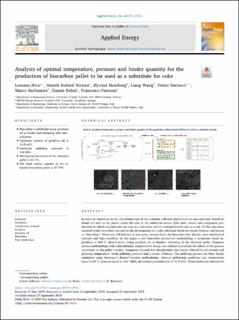| dc.contributor.author | Riva, Lorenzo | |
| dc.contributor.author | Nielsen, Henrik Kofoed | |
| dc.contributor.author | Skreiberg, Øyvind | |
| dc.contributor.author | Wang, Liang | |
| dc.contributor.author | Bartocci, Pietro | |
| dc.contributor.author | Barbanera, Marco | |
| dc.contributor.author | Bidini, Gianni | |
| dc.contributor.author | Fantozzi, Francesco | |
| dc.date.accessioned | 2020-03-27T07:02:33Z | |
| dc.date.available | 2020-03-27T07:02:33Z | |
| dc.date.created | 2019-09-22T07:17:25Z | |
| dc.date.issued | 2019 | |
| dc.identifier.citation | Riva, L., Nielsen, H. K.,Skreiberg, Ø., Wang, L., Bartocci, P., Barbanera, M., Bidini, G. & Fantozzi, F. (2019). Analysis of optimal temperature, pressure and binder quantity for the production of biocarbon pellet to be used as a substitute for coke. Applied Energy, 256: 113933. doi: | en_US |
| dc.identifier.issn | 1872-9118 | |
| dc.identifier.uri | https://hdl.handle.net/11250/2648997 | |
| dc.description.abstract | In order to contribute to the decarbonization of the economy, efficient alternatives to coal and coke should be found not only in the power sector but also in the industrial sectors (like steel, silicon and manganese production) in which coal and coke are used as a reductant and for steel production also as a fuel. To this aim many research works have been focused on the development of a coke substitute based on woody biomass and known as “biocarbon”. There are still barriers to overcome, among them: the biocarbon low density, poor mechanical strength and high reactivity. In this paper a new biocarbon production methodology is proposed, based on: pyrolysis at 600 °C, densification (using pyrolysis oil as binder), reheating of the obtained pellet. Response surface methodology with a Box-Behnken experimental design was utilized to evaluate the effects of the process conditions on the pellet's quality. Responses showed that densification was mainly affected by oil content and pelleting temperature, while pelleting pressure had a minor influence. The pelleting process has been finally optimized using Derringer's desired function methodology. Optimal pelletizing conditions are: temperature equal to 60 °C, pressure equal to 116.7 MPa, oil content concentration of 33.9 wt%. These results are relevant for metal production industries at a global level. The identified optimal parameters of the new biocarbon production process can contribute to replace coke with sustainable fuels and probably reduce great part of the related greenhouse gases emissions. | en_US |
| dc.language.iso | eng | en_US |
| dc.publisher | Elsevier | en_US |
| dc.rights | Navngivelse 4.0 Internasjonal | * |
| dc.rights.uri | http://creativecommons.org/licenses/by/4.0/deed.no | * |
| dc.title | Analysis of optimal temperature, pressure and binder quantity for the production of biocarbon pellet to be used as a substitute for coke | en_US |
| dc.type | Journal article | en_US |
| dc.type | Peer reviewed | en_US |
| dc.description.version | publishedVersion | en_US |
| dc.rights.holder | © 2019 The Author(s) | en_US |
| dc.subject.nsi | VDP::Teknologi: 500 | en_US |
| dc.source.volume | 256 | en_US |
| dc.source.journal | Applied Energy | en_US |
| dc.identifier.doi | 10.1016/j.apenergy.2019.113933 | |
| dc.identifier.cristin | 1727502 | |
| dc.relation.project | Norges forskningsråd: 294679 | en_US |
| dc.source.articlenumber | Peer reviewed | |
| cristin.qualitycode | 1 | |

